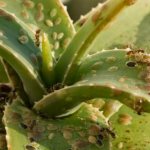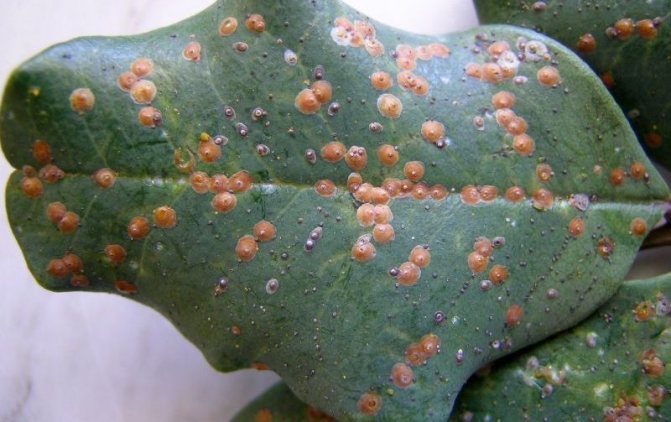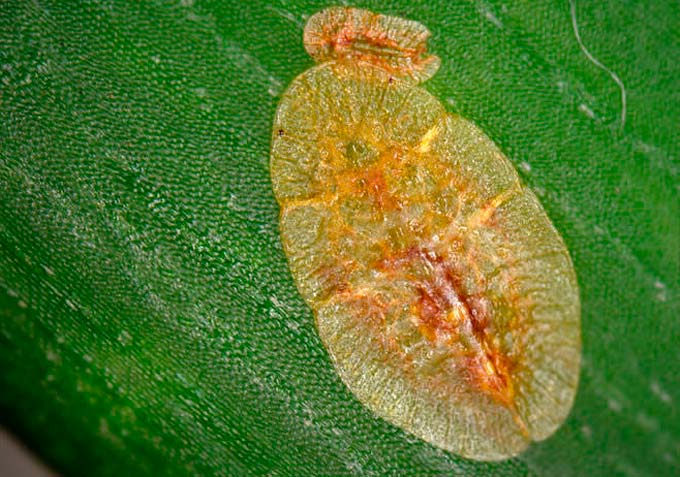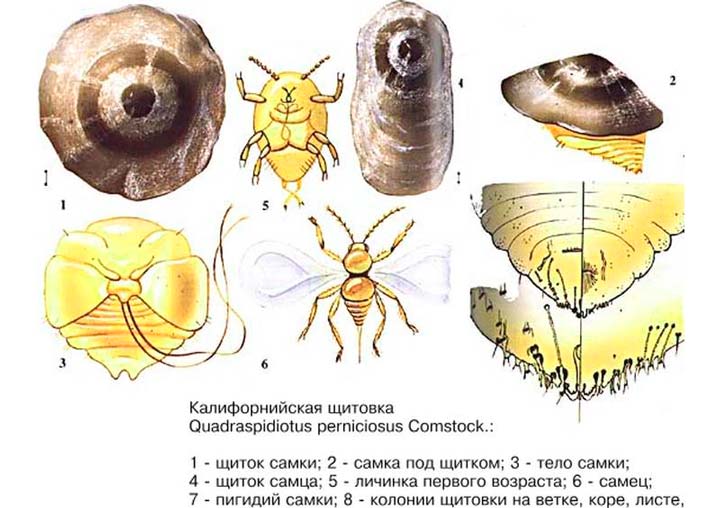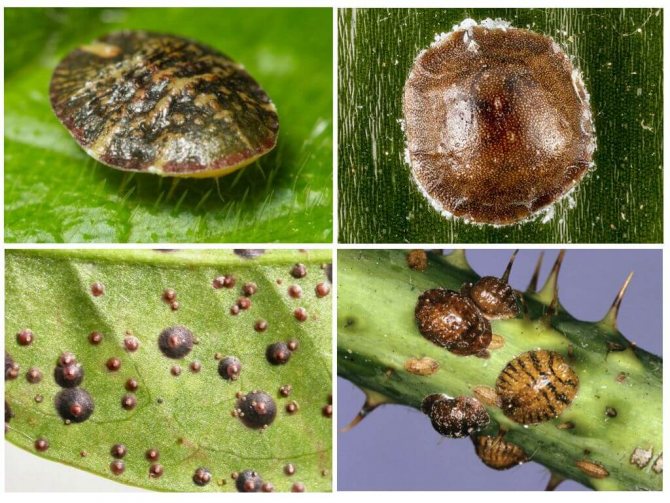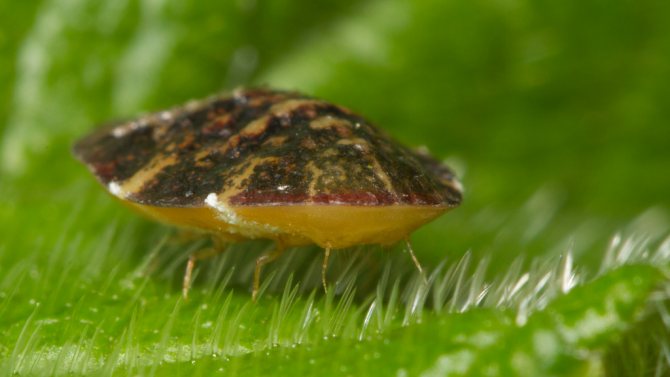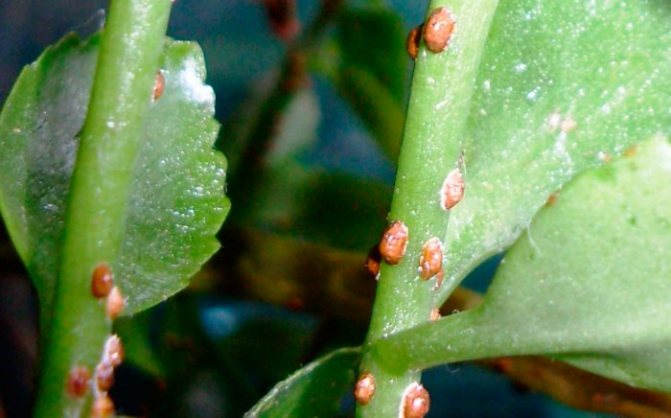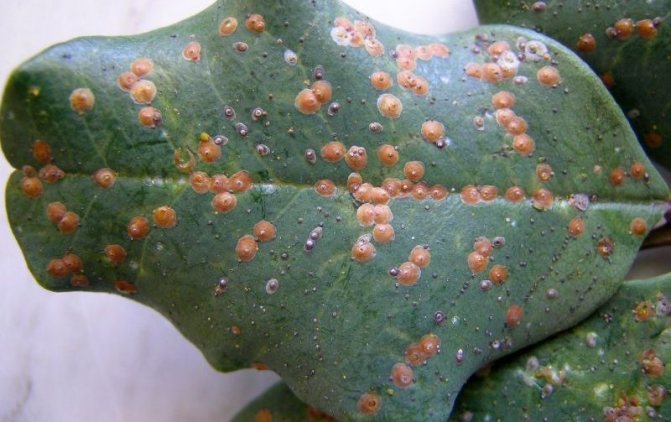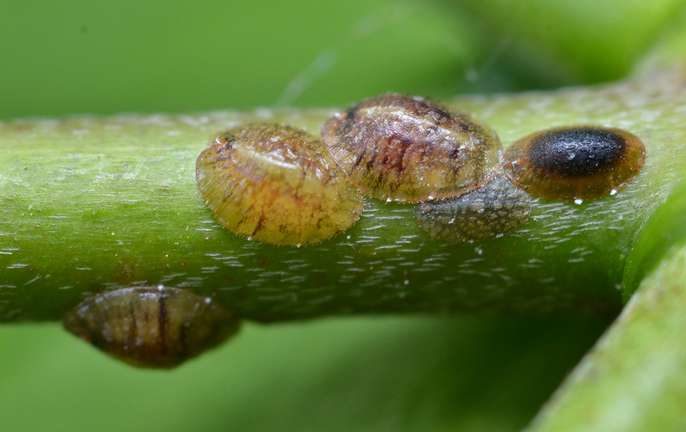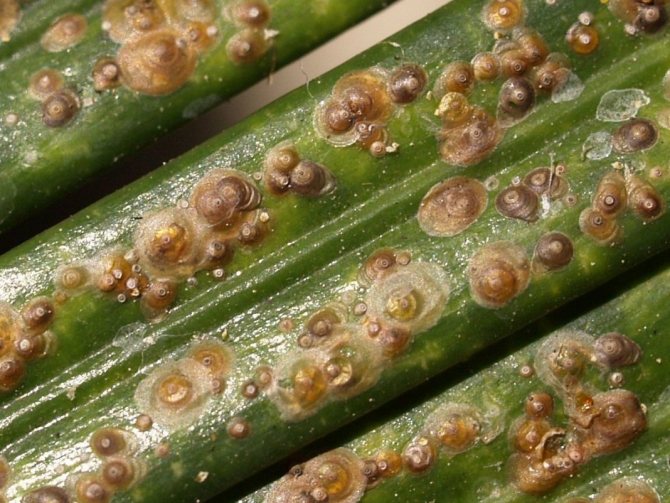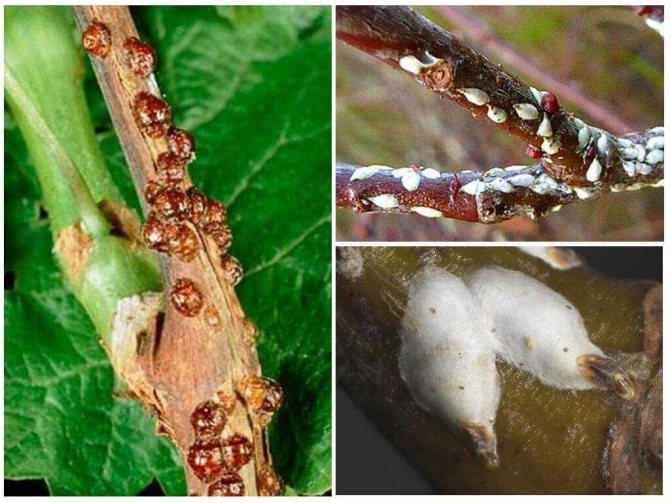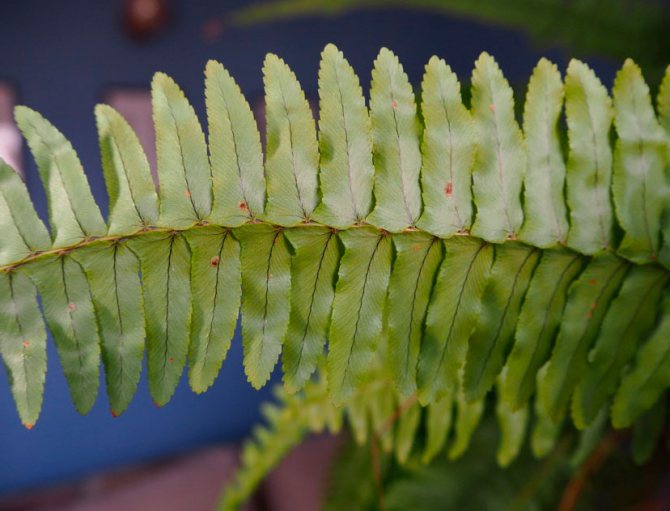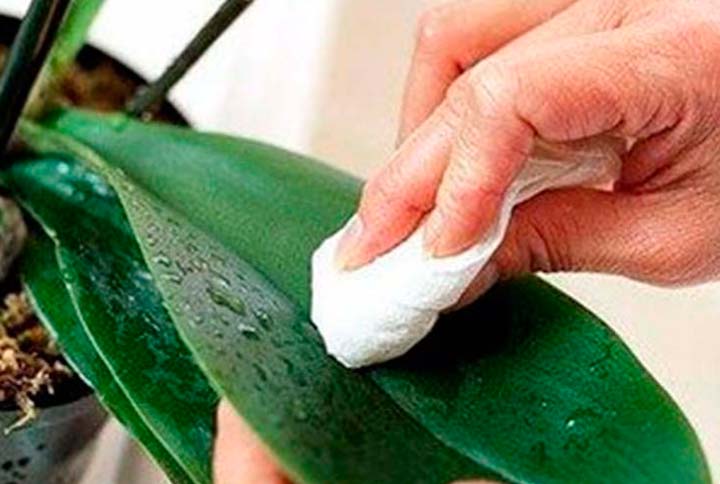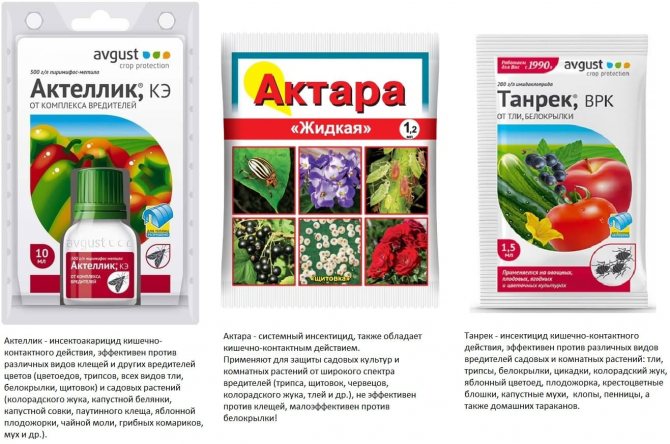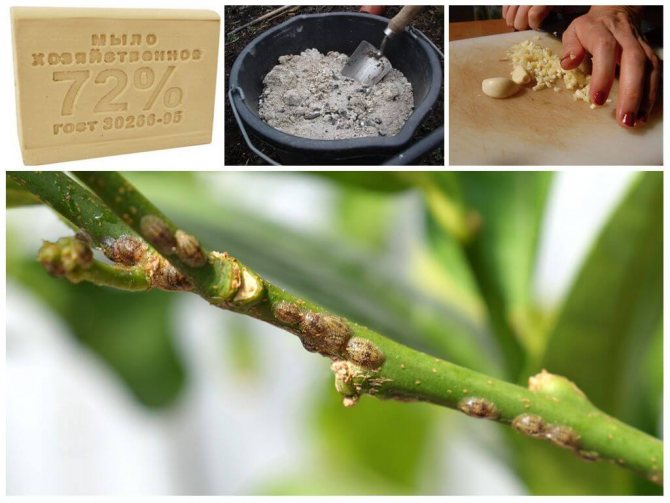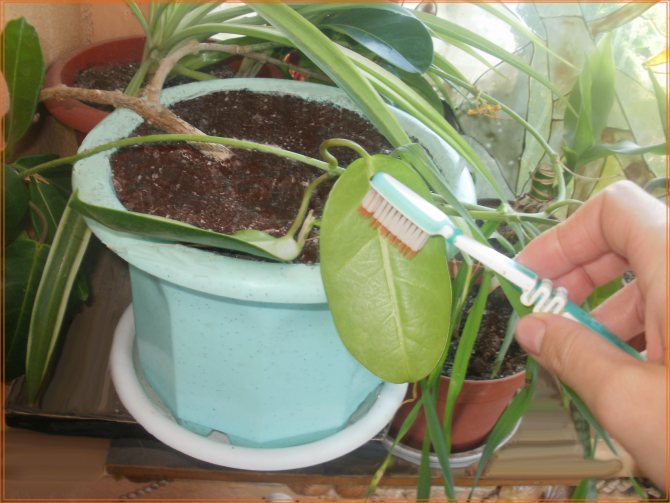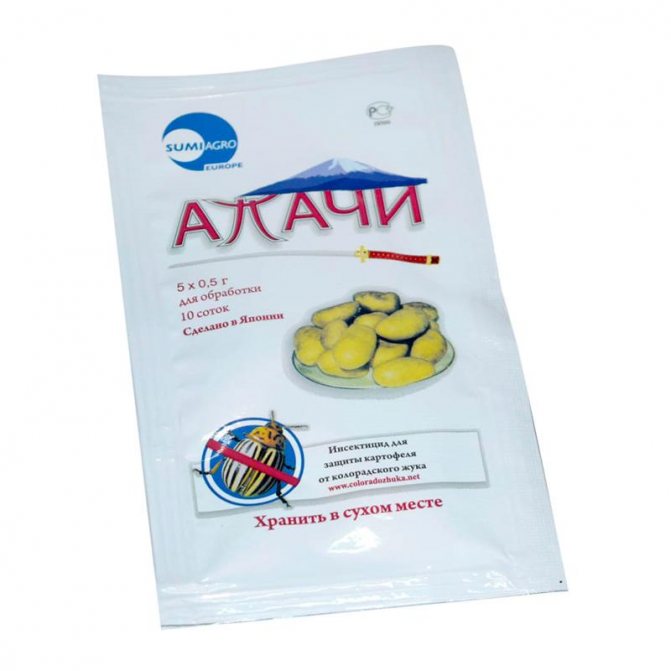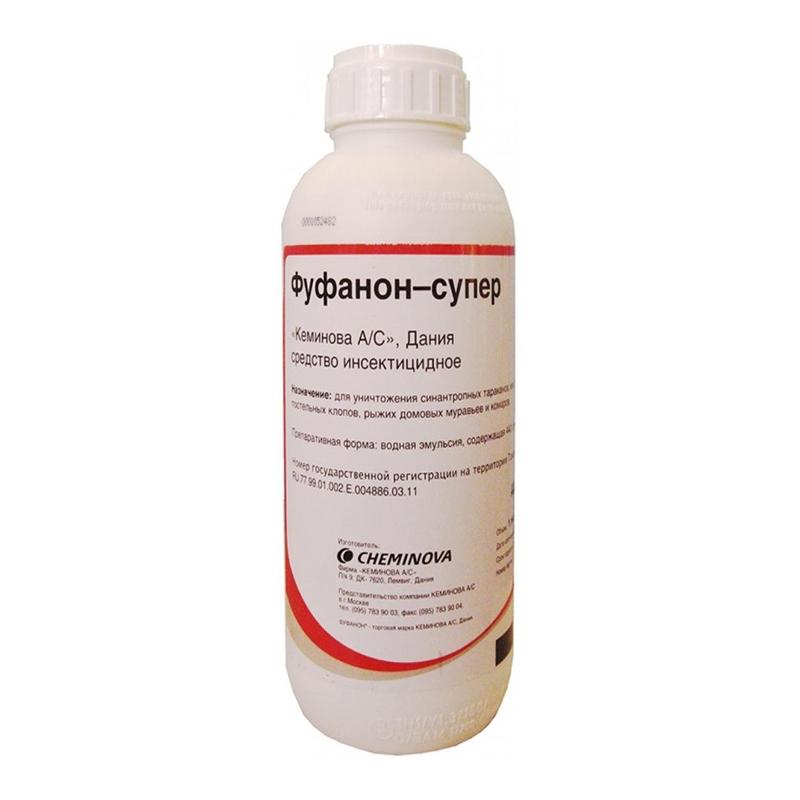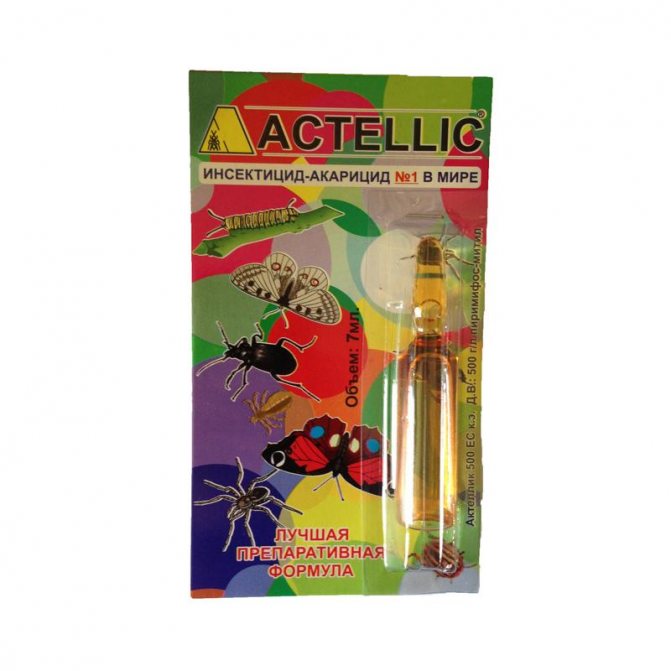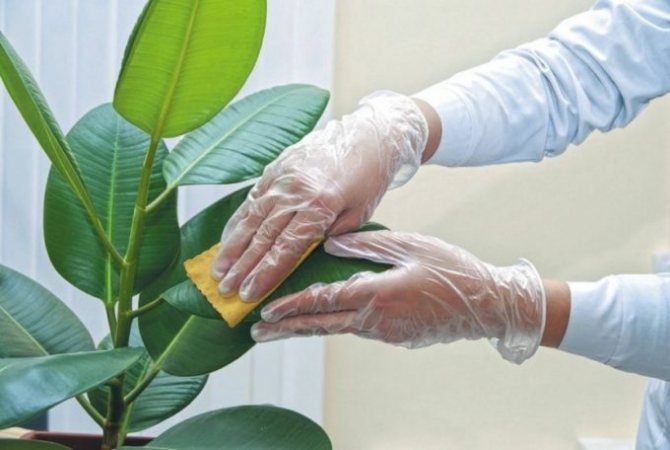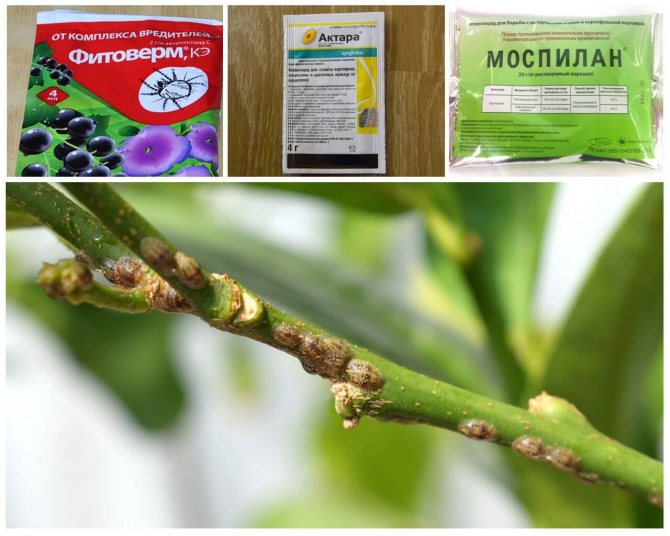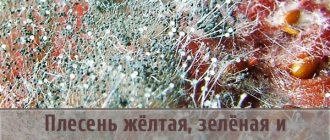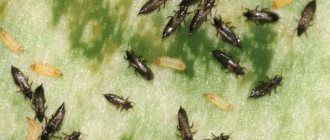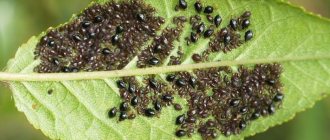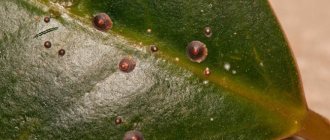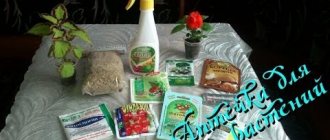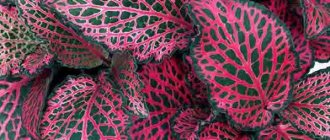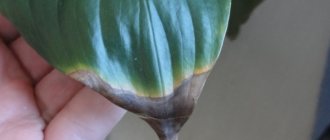The scabbard, as well as the false scabbard, is a harmful insect that can infect various plants. It poses a danger to a huge number of indoor plants. But especially laurel, citrus fruits, oleadra, palm, and also amaryllis can suffer from it.
Scale insects (Diaspididae) are members of the family of homoptera of the coccid suborder. Their body is rounded. And it is noteworthy that females have coatings in the form of wax shields on top of their bodies.
The false shield is a representative of a different family (Coccidae or Lecaniidae), but belongs to the same order of coccids. Their size is much larger than that of scale insects, or rather, from 3 to 7 millimeters. These insects do not have a shield, and the eggs and larvae are protected by the dried body of the female.
In both the false-scale insects and the scale insects, the difference between females and males is quite large. After the female becomes an adult, she stops moving, thus protecting the eggs attached to the surface of the plant. On the contrary, not very large males are quite mobile. At first, the larvae are also very mobile, but when they attach to the plant, they become immobile and they have a wax shield.
general description
What does this insect look like? This is a tiny creature that can destroy even a large tree. Its body is covered with a dense protective shell, so the scale insects can be mistaken for hard growths on the plant. It is not for nothing that the scale insect has a second name - the garden turtle. But they are not at all as harmless as they might seem at first glance. In a couple of weeks, the voracious creatures will destroy any plant.
Every gardener should know well what a scabbard looks like on indoor plants, how to fight. The photo shows us females up to 5 mm in length. It is they that are found motionless on plants and look like droplets of solidified resin. Males do not grow more than 3 mm and move freely through the plants using legs or wings.
Pest information
The scale insect belongs to the Homoptera family, it feeds on the sap of the plant, leading to its death. Depending on the variety, the length of an adult varies from 0.5 to 5 mm. The insect is protected by a dense waxy thyroid shell. On the leaves, the scabbard looks like a dense tubercle.
Males and females are different. Females have a convex, rounded shell, no wings, legs, and sometimes eyes. They are completely motionless. Males are smaller, covered with an oblong flattened shell. They have normally developed limbs, there are wings, but the mouth is reduced. Males live less - they die soon after mating.
Insects leave eggs on the leaves and stems. The first days after emergence, the larvae are active, then they attach to a leaf or stem, become immobile. As they grow, they molt. Gradually, from the wax secretion and discarded skins, a shield forms around them.
Inexperienced growers often confuse scabbard with false shield. In a real scale insect, when trying to remove an insect from a plant, the shell is separated. The false shield is completely detached.
Reason for appearance
Everything is clear in the garden: young females and males fly freely and cover decent distances.And how does the scabbard appear on indoor plants? How to fight? We will consider a photo of effective drugs a little lower, but for now we will consider the ways of entering your home. These are usually soil, plant debris and water. And more often than not, parasites come to your house with new plants.
They usually begin to fight them when they appear in large numbers, before they simply did not notice. Therefore, a new generation of scale insects is creeping into neighboring pots. And only a sudden, massive shedding of leaves, inhibition of growth or death of plants can be a signal for the owner that it is time to show maximum attentiveness.
What types do flower growers most often encounter?
Varieties of scale insects:
- Orange. Prefers laurel and citrus plants.
- Cactus. Grayish, the name corresponds to the habitat.
- Euonymus. The scutellum of females is similar to a pear, deep brown. In males, the shell is white.
- Palm. Likes to settle on both sides of the palm leaf. Scutellum is white-gray, 2 mm in diameter.
- Ivy. The main delicacy is ivy, asparagus, dracaena, yucca, oleander. The shield is slightly convex, 2 mm, yellow.
- Pink. The female is yellow with a shield convex in the middle. Male with pale red coat.
- Oleander. The male is brown-yellow in color with a whitish bloom. The female's shield is irregular, 2 mm in diameter, almost flat, white with yellow covering skins.
- Laurel. The female is pale cherry in color, the scutellum has the shape of a shell. The male is the same color.
- Brown, Chrysomphalus dictyospermi, the most common pest. The most common pest with a diameter of about 2 mm. Damages trunks, leaves and fruits of plants.
Varieties of false scale insects:
- Olive. The place of settlement is laurel, oleander, citrus fruits. Dark brown, has a H-shaped growth on the back. Very prolific, the female is capable of laying up to 2,500 eggs. The colony causes the shoots to dry out.
- Soft. Ovoviviparous, one of the most common false shields. Females are yellowish-brown, with an asymmetric body, broadly oval, up to 4 mm. The distribution of individuals along the veins of the leaves is characteristic, which leads to their twisting. Prefers palms, orchids, citrus plants.
- Oblong pad. Greenish-yellow, round-oval, with a slightly convex body. The female has a white egg sac that can hold up to 2000 eggs.
- Hemispherical. Brown or yellow-brown color, convex spherical body, up to 5 mm. Fertile enough, clutch reaches 2500 eggs.
Threatened
The scabbard on indoor plants can appear no matter how well you care for them. Moreover, it infects any plant, including succulents. But this pest also has pets that are attacked in the first place. We are talking about orchids and laurels. Scabbards do not bypass palms and ivy. With great pleasure the scale insect, Cyperus, Aucuba and other exotics are feasting on. The usual domestic inhabitants are also under attack: chlorophytums, geraniums and hippeastrum.
Remarkably, the pest most often appears in winter and early spring. This is evidenced by numerous amateur photos. How to deal with the scale insect on indoor plants? It is necessary to deal with increasing the immunity of plantings. Indeed, at this time the plants are most weakened, which becomes a decisive factor for the pest. It is much easier for them to harm flowers that are not able to resist. Therefore, observe the recommended conditions, and closer to spring, introduce special immunostimulants into the soil. It can be inexpensive succinic acid.
The difference between females and males
Insects of both species are characterized by sexual dimorphism:
- Females are larger. Newly hatched individuals have legs that help them to conquer new territories at a relatively high speed.Having fixed herself in the place she likes, the female firmly bites into the plant, slowly grows and becomes covered with a protective shell. She can no longer move, here she will make a clutch for reproduction, here she will die.
- Males are much smaller in size, have a pair of wings, developed limbs. During a short life (about two days), they are able to cover long distances.
Californian scale insect and her family
Harm done
The larvae are waiting in the wings, feeding on cell sap. With a strong defeat, the plants are covered with a bloom from the bodies of pests, and it is almost impossible not to notice this. Autumn is coming in your home garden, the leaves are flying around.
On indoor plants, the scale insect and its larvae can live and feed all year round, while insects breed very quickly. They reproduce by laying eggs, which promotes rapid population growth. At the initial stage, the larvae are very mobile, especially the males. But they live only a few days, and the female will feed and reproduce for several months.

Types of scale insects
In nature, there are a fairly large number of species of scale insects that can harm any indoor plant. But they are very similar to each other, the difference is only in size and color.
- scale brown - most often this insect affects: ficuses, laurel, palm trees, camellias, citrus fruits, yucca, dracaena, boxwood, oleander, hibiscus and other plants;
- scale cactus - most of all prefers to settle on cacti;
- scabbard olive - settles on oleander, laurel, camellias, pomegranates, citrus fruits, hibiscus, fat women;
- scaled palm - can seriously harm palm trees. Most often, these insects damage young leaves of fan palms that have not yet blossomed. They are also dangerous for bromeliads, orchids and other tropical plants grown at home.
Do not confuse with false shields
This is another pest that looks very similar in appearance. These insects belong to the same order, but they are separated into a separate family. They differ from scale insects in that the latter do not have a wax shell. Their eggs and larvae are protected by dry skin of a female dying after laying. In the first stages, small insects move quickly, and this applies to both true and false scales. But if you see that a sticky span begins to form on the leaves, there is no longer any doubt: they are in front of you.
Signs of insect parasitism
If the leaves are found to be sticky, then scale insects have settled. They may still be invisible, but they already highlight the secret. As insects grow, brown, green, yellow tubercles are found along the veins of the leaves. These are scale insects that are attached to the leaves, often from below, but can be on top.
The leaves are covered with spots, then turn yellow. Insects drink the juice, so the buds fall off on the flowers, the development of the stems is incorrect. Signs of the rapid death of the plant: growth gradually stops, the leaves fall off, the bush dries out.
Preventive actions
Below we will talk about how to deal with the scabbard on indoor plants, but for now, let's take a look at what can be done to prevent defeat. The following measures will help protect your flowers:
- Continuous soil control in plant pots. It must be of high quality and clean.
- Dead and weak shoots must be cut off in time. This will preserve the vigor of the plant and prevent rotting. Be sure to disinfect the sections.
- Ventilate the room frequently and maintain adequate air humidity.
- Quarantine all new plants for a month. A similar technique should be used when returning your plants from summer living in the garden, in the fresh air. In the garden, there are quite a few chances of contracting the scabbard.
You need to know the enemy by sight
Plants affected by the scale have their own distinctive features.
We suggest you familiarize yourself with: How to get rid of silverfish - how to deal with silverfish
With enough attention, you can quickly see and eliminate the insidious enemy:
- Not possessing sufficient mimicry, the plaques of scale insects are still noticeable on the leaves and stems. Looking into the axils of the leaves, probing the trunk of the plant for roughness, it is easy to notice bulges and tubercles that are not inherent in the plant.
- Scabbards secrete a kind of sticky liquid (pad). Sticky in consistency, it covers the leaves with uneven spots; in case of a strong invasion, it even leaves traces on the surrounding stands and the floor. If you notice that the dust on the sheets has begun to settle uncharacteristically densely, the leaves have ceased to shine or, conversely, have acquired an uncharacteristic shine, stick to each other, then there is a reason to panic.
- A sooty fungus, which is often confused with other plant diseases, is very fond of settling in places where honeydews accumulate. It does not feed on sap, but it strongly spoils the appearance of the plant and clogs the pores on the leaves, impairs photosynthesis, and leads to their gradual death. Washing has little effect without removing the root cause.
- The false shield not only sucks out the sap of the plant, but also injects a poisonous liquid that harms the plant. The appearance of dying foci, for example, on orchids, will give a signal for a thorough examination.
- The plant, with normal watering, suddenly begins to wither, dry out. Additional watering only accelerates the death of the plant, leading to rotting of the roots. And the reason may be the accumulation of a colony of scale insects at the base of the plant stem.
- Scabbards are almost omnivorous. A favorite delicacy, according to the observations of flower growers, are cyperus and laurel. If any variety of plants is present in the collection of plants, the scale insect attacks them in a strange way with the main composition. But she does not disdain other plants either. Tsiperus is like litmus paper: if uninvited guests appear on it, there is a reason to send other pets for prevention.
Control methods
The more pests have time to breed, the more difficult it will be to get rid of them, and the more severe the damage inflicted. And the first remedy for scale insects on indoor plants is picking them from the leaves by hand. It should be noted that the fight against these creatures is long and very difficult. A durable shell reliably protects pests from any damage. Therefore, first of all, we examine the sinuses and leaves from both sides. A small flat build-up is a pest. It must be carefully torn from the plant and destroyed. To facilitate this task, you can use a toothbrush. This is only the first, but very important step. Because by leaving pests on the stems, you give them a chance to reproduce.
What is this insect?
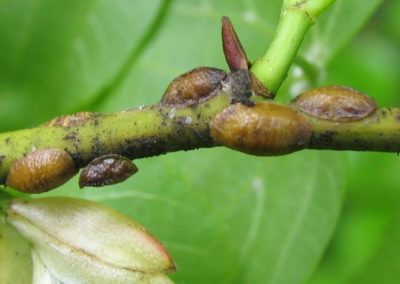

One of these worst enemies of indoor flowers is the scabbard. She can completely destroy all plants in the house in a matter of weeks. And she does not spare even semi-poisonous flowers.
Outwardly, the scabbard resembles tubercles, which are practically motionless on the stems and leaves. The size of these insects does not exceed 5 mm. Females are inactive, larvae develop under their dense shell. But young scale insects and males easily move along the stems and leaves of the plant. So they fly over and crawl to neighboring plants.
Therefore, having found a pest on one indoor flower, you can find it on others. These pests reproduce by laying eggs on the back of the leaf or on the stems of the plant. The masonry is so microscopic that it is almost impossible to notice it.
The thyroid glands feed on plant sap, which they suck from the stem and leaves. First, young and juicy shoots fall under its attack, then it moves on to the already formed parts of the plant.
Important! A massive attack of these pests destroys an adult plant in a couple of weeks, leaving behind only the root and a dried-up trunk. After the scale insect has eaten half the leaves, it is almost impossible to save the plant.
It will also be useful to find out what types of scale insects are. You can read about it here.
Hygiene measures
The fight against the scale insect on indoor plants begins with treatment with a soapy solution. This is not tolerated by most pests. Moreover, it will be necessary to process both the placement of the pots and the vessels themselves. It is best to replace the soil by first calcining the fresh soil mixture.
To prepare a concentrated soap solution, you will need 100 g of grated laundry soap and a liter of water. After complete dissolution, add 200 ml of kerosene. All this must be thoroughly mixed until a white foam forms. Before use, the mixture must be diluted in 10 liters of water. After wiping with this solution, the plant is given a warm shower after a few hours, after which it is placed in a warm place to dry. This is one of the most gentle remedies, but it can be quite effective. True, there is a chance that the larvae will survive and give birth again. It may take 2 - 3 treatments at intervals of 7 days for a complete victory. Dealing with scale insects on houseplants can be long and difficult, so let's look at more reliable remedies.
How to deal with a scabbard?
If a dangerous pest is found, it is advisable to immediately isolate the plant and check all nearby flowers. The choice of methods for further struggle depends on the degree of defeat.
Chemicals and processing rules
If you cannot get rid of the pest mechanically, then you have to use insecticides. It should be noted that females and their ovipositions are well protected by shields, so it is unlikely that it will be possible to cope with them with a single treatment.
You can use the following tools:
- Fitoverm is of biological origin, and therefore is not as dangerous to humans and pets as some other chemicals. This insectoacaricide is of an enteric type of action. It is necessary to dissolve 2 ml of Fitoverm in 200 ml of water and spray the affected plant. For the desired result, 3-4 treatments with an interval of 5-8 days should be enough. In order to strengthen the plant, at the end of the procedure, the use of Epin (growth stimulant) will be useful.


Confidor is a systemic and contact drug. Despite its effectiveness (it affects pests for 15-30 days), it is considered moderately dangerous for animals and humans. Dissolve 1 g of Confidor in 0.5 l of water (4 ml per 10 l), and then spray the plant and soil.- Aktara is an enteric-contact insecticide that, when sprayed on a leaf, is effective from 2 to 4 weeks. For spraying on the plant, a solution should be made of 1 g of the product and 1.25 liters of water (warm, at least 25 degrees), and for watering the soil - 1 g per 10 liters. It penetrates through the roots and blood vessels into the leaves, making them toxic to pests. The interval between 2-4 procedures is 10-12 days. So that the insect is not addictive, this drug can be alternated with others.
- Actellic is a potent organophosphate insectoacaricide with a broad spectrum of action. Very toxic, helps out in a difficult situation. Enough 2-3 treatments (after 3 days). For 1 liter of water, you will need 2 ml of the product.
Advice!
Preparations should not be washed off immediately. You can cover the flower with plastic for 30 minutes, and then start washing. In addition, it is recommended to remove the top layer of the soil, because there may be parasites.
In order to combat the scabbard, you can also use drops Avanpost, Advantiks, which rid indoor dogs and cats of fleas, lice, ixodid ticks.A small capsule should be diluted in 0.5 l, a large one in 1 l, then moisten the leaves on both sides, as well as the sinuses, stems, petioles and even the ground. A single treatment may be sufficient. If the defeat is large-scale, then you need to repeat everything after a week. The procedures are recommended to be carried out outdoors: on the street or on the balcony.
Traditional methods and prevention
The key to the success of using traditional methods is careful processing. Their main plus is environmental friendliness. Various remedies are popular:
- Soap solution. It is necessary to individually wipe all the leaves and stems with a cotton pad, sponge or soft bristles of an old toothbrush soaked in a solution of tar, household or green potassium soap. It is advisable to cover the ground temporarily. After 2-4 hours, the foam should be washed off with hot water (up to 50 ° C). It is believed that such a solution clogs the pores and disrupts the photosynthesis of the plant.


- Vinegar. Dilute the product in water so that the solution becomes slightly acidic, and then wipe and spray the affected object.
- Tinctures of garlic, onion, hot pepper, tobacco. The crushed components are individually infused in 0.5 liters of water (5 cloves of garlic - 1-2 days, 1 onion - 2-3 hours, 50 g of pepper - 1 day, 80 g of dry tobacco - 1 day), filtered through cheesecloth and used for spraying or wiping. Tobacco and pepper infusions are diluted in 1 liter of water.
- Oil (olive, sunflower, machine oil, neem). Beat until foamy in a glass of water 10-15 g of soap, mix 2 tbsp. sunflower and olive oil (or 15-20 ml of machine oil), completely rinse the plant with the resulting liquid and rinse off after 6-9 hours.
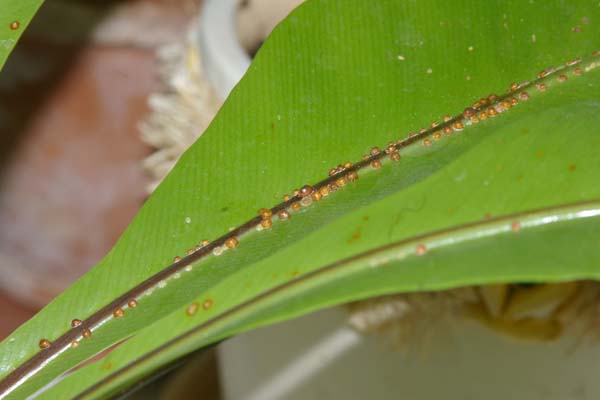

Neem oil is used as a biological product to combat many insects and, of course, the scabbard. You just need to apply it to cotton wool and process all the organs of the plant. Some experienced florists claim that this procedure is effective. It can be done simply for prevention.
- Kerosene. Add 5 drops of kerosene to a soapy solution (40 g of soap and 1 liter of water) and shake well, and then spray or wipe the habitat of the scabbard.
- Alcohol. As in the case of kerosene, add any alcohol, vodka to a soap solution (1 spoon of soap shavings per 1 glass of water) and then dilute with water (300 ml). To prevent the flower from getting burnt, it is necessary to wash off the product with warm water 10-15 minutes after treatment. Alcohol and kerosene can damage delicate plants.
Note!
To completely get rid of pests, you need to carry out several treatments with regularity 1-2 times a week.
Prevention will help protect green favorites. Preventive measures include:
- quarantine of new plants;
- washing hands before contact with the flower;
- observance of hygiene of the locations of flower containers;
- regular inspection, it is especially important to examine the lower part of the leaves (it is better to use a magnifying glass);
- airing and spraying;
- moderate watering;
- seasonal feeding to strengthen the immunity of plants.
Transplanting a plant with scale insects is not recommended.
Folk ways
So, we cleaned the plant from pests with a toothbrush, washed it with soapy water and dried it well. Now we consider further how to deal with the scabbard on indoor plants with available means:
- A garlic solution gives a good result. To do this, pour 5 crushed cloves with a glass of water and insist in a dark place. After that, strain through cheesecloth and spray the plant with the solution. You need to carry out a number of treatments to get a good result.
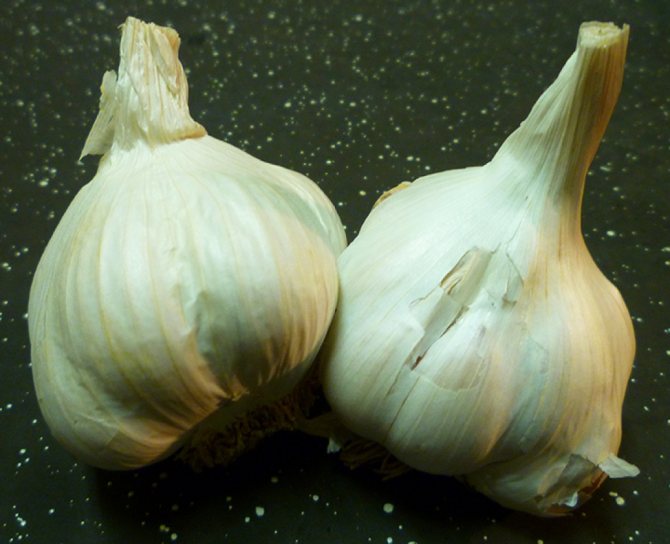

- Pepper infusion. Its advantage is also that the solution can be prepared for future use. To do this, boil 50 g of pepper for 5 minutes in 500 g of water. Let stand for 24 hours - and the infusion is ready.
- Celandine. Almost all pests cannot tolerate it. You will need to pour 300 g of dry herb celandine with a liter of boiling water.Insist for a day, then spray the diseased plant.
- Oil film. Insects are living creatures that require air. To block its access, you can lubricate the affected areas with sunflower oil using a brush. The procedure is repeated every day until the insects disappear completely.
The effectiveness of folk remedies is quite difficult to assess. They are safe for humans, which is a big plus. But often growers are faced with the fact that the result is temporary, and comparable to the manual collection of pests. After a few days, the larva hatches, and the surviving individuals lay new eggs. And now a new generation of pests is destroying your flowers. Of course, on the scale of the garden, it is more difficult to deal with them. But if you have 3 - 5 pots at home, then you can check every leaf every day and not give the pest a single chance.
Plant processing rules
Having found even one scale insect on the plant, it is isolated. They are checking the rest, it is possible that pests have also settled on them. The earlier parasites are identified, the easier it is to fight them. The larvae are destroyed by all available means, and the adults, thanks to the shield, are insensitive to folk remedies, insecticides will be required.
It is easier to remove scale insects from plants with large flat leaves. They should be examined regularly, and adults and larvae should be manually removed. It is easy to wash such plants, but if the leaves are small, difficulties arise. One manual scrubbing will help, but the scabbards are completely removed with insecticides.
After removing the insects, the leaves on both sides are wiped with a solution: soap, kerosene, alcohol. Remember to wipe off the trunk and branches. Then they are treated with insecticides. Wipe the place where the flower stood, window glass. The pests are very small, so they are invisible on the surface.
Orchids
The first mandatory measure after the detection of scale insects is the isolation of the plant. If there are no chemicals, folk remedies are not prepared, they take simple emergency measures. The orchid is placed under the tap, washed with a gentle stream of warm water, then treated with soapy water. Plants can be moistened by frequently spraying them with warm water.
Another way is more effective. The orchid, along with the pot, is covered with a plastic bag. Conditions with high humidity are formed, which the larvae cannot tolerate and die. To prevent the flower from disappearing, every day the bag is removed for half an hour for airing. Pest control measures are complemented by the use of insecticides. The plant and soil are treated with solutions.
Velcro for flies and mosquitoes is installed next to the quarantined orchid. Scabbards can move to other plants, clinging to an insect.
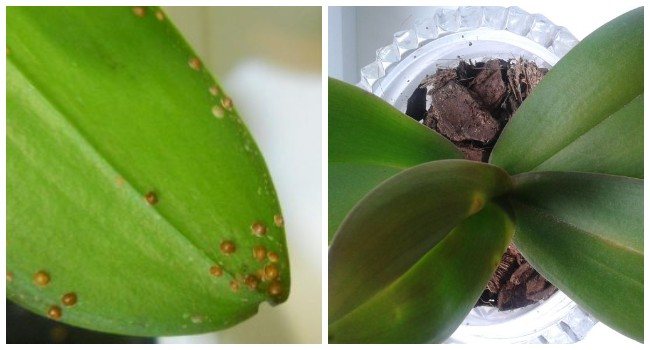

Lemon
It is better to refrain from using insecticides on lemon. Citrus growers consider a soap solution with 5 drops of kerosene per 1 liter of water to be the best remedy. A film of soap blocks the air access for the scale insects, kerosene, getting on the body of pests, acts like a poison. The solution is completely treated with citrus, after 3 hours, washed off with water.
To make the plant recover from stress faster, it is fed with the Epin biostimulator. The drug for treatment is applied by spraying.
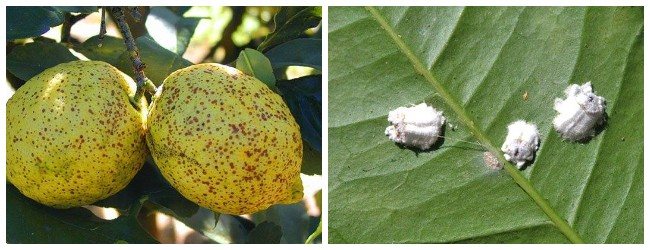

Ficus
Scabbards are removed from plants by hand. They use a sponge dipped in a soap and kerosene solution. Scrape off the branches with a knife. Shoots, leaves of Benjamin's ficus and other species affected by the scabbard are removed. At the same time, chemicals are used 3–6 times with breaks a week.
Other plants
Treatment of plants against scale insects gives a result if complex measures are applied. Begin by rinsing with warm water, soapy water. If the size of the plants allows, arrange a mini-greenhouse, covering the plant with a plastic bag. Manual processing is carried out by removing the scabbards.
Only chemical treatment will bring temporary results. The larvae die, and many adult scale insects, covered with a shell, survive. New larvae soon emerge from the eggs.
Prevention of re-infection
Prevention of scabbard infestation includes the following measures:
- new plants are not placed immediately next to the old-timers, but are quarantined;
- regularly examine green pets in order to detect pests earlier;
- wash their hands before caring for houseplants.
Consider that scale insects do not like dry air and sun. Crowding is avoided by placing plants. Water in moderation, often ventilate the room.
The need for preventive measures increases at the end of winter. At this time, they take special care of airing, regularly inspect the plants, spray them with water.
Scabbards in the top five most dangerous pests of indoor plants. The shield is a reliable protection against the effects of solutions, including chemical ones. Therefore, it is important to detect the scabbards in time in order to start the fight.
We use insecticides
A photo of a scale insect on indoor plants makes it possible to understand that it is capable of causing serious damage to any flower, up to its complete death. Therefore, at the first signs of defeat, you need to get down to business. And the most effective way to combat is the use of insecticides, that is, treatment with chemicals. But here, too, there is no guarantee that you will manage with one treatment, because a systematic approach is needed to combat this pest. The choice of drugs is quite large today. But the most effective can be considered those that are designed to combat dipterans, including the Colorado potato beetle.
Habitat
The scale insect is settled all over the world, many species came to us from other continents. Insects have many ways to expand their range. From remote regions, other countries, the pest enters along with the plants imported by importers. It is not easy to find it in small quantities, so when buying a flower in a store there is no guarantee that a pest will not enter the house.
One female is enough, which can produce offspring without an individual of the opposite sex.
Scabbards live on indoor flowers in the garden. Plants wither and die from the invasion of pests. You can bring insects home in the following ways:
- pick flowers on the field;
- buy an infected plant, from where the scale insects will move to others;
- pests can migrate from neighbors through the balcony, where flowers are exhibited in the summer;
- rarely, but it happens that they are carried by the wind.
Interesting! Pests are able to move to new places along with other insects that can travel long distances.
"Aktara"
If you have tried folk methods and are still looking for options on how to get rid of the scale insects on indoor plants, then it's time to move on to more radical measures. This drug affects the nervous system of insect pests, causing paralysis of the respiratory and nervous systems. The product is produced in ampoules, which is very convenient.
This product kills insects feeding on plants at all stages. The drug works equally well when applied to leaves and watering at the root. That is, it accumulates in the vegetative parts of the plant, which makes it resistant to precipitation.


Signs of defeat with a photo
The harm of scale insects for home flowers is the suction of juice by insects. The plant begins to dry out gradually, eventually dies. There are three ways to find the scabbard.
- Plaques. Convex spots resembling plaques appear on the leaves and stems. Color - from light yellow to brown.
- Sticky coating. Even in the early stages of infection, drops of sticky transparent liquid appear on the plant. Gradually, the entire flower is covered with bloom.
- Stopping growth. The plant stops growing, withers, the leaves turn yellow and fall off.
Scabbards multiply rapidly, leading plants to death. Often, a sooty fungus appears in places where sticky secretions accumulate. Dark plaque can be easily washed off with water. The pores are clogged, photosynthesis is disrupted - without treatment, the plant dies.


"Actellik"
And we continue to talk about how to deal with the scale insect on plants. "Actellic" is a popular insecticide that allows you to quickly deal with garden parasites. The drug "Actellik" EC, that is, a concentrated emulsion, packaged in 2 ml ampoules, contains the active ingredient pirimiphos-methyl. It is able to affect the pest in the following ways:
- Through the outer shells.
- Through the digestive organs.
- through the respiratory tract.
The emulsion is widely used for indoor plants. It is non-toxic to humans and pets when used correctly. Today it is one of the best remedies for scabbard control.
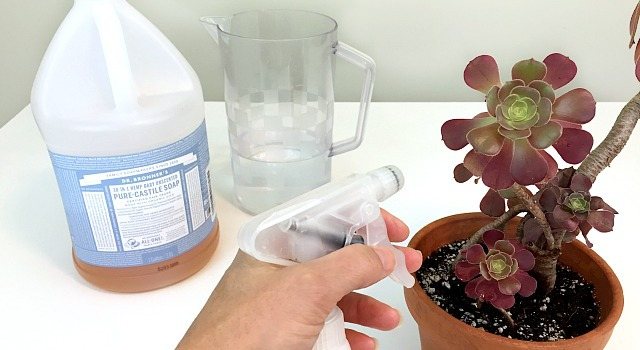

Which houseplants are at risk?
More often insects settle on such plants:
- ficuses of all kinds;
- palms, especially fan palms;
- citrus fruits;
- orchids;
- chefs.
Insects do not leave their attention to hibiscus, dracaena, oleander, yucca, anthurium. Damaging the protective shell, pests contribute to the fact that fungi easily penetrate through the wounds in plant tissue.
To defeat the infection, indoor flowers are treated with a biological product "Fitoflavin", which destroys almost all fungal diseases. The dosage is 2 ml per 1 liter of water.
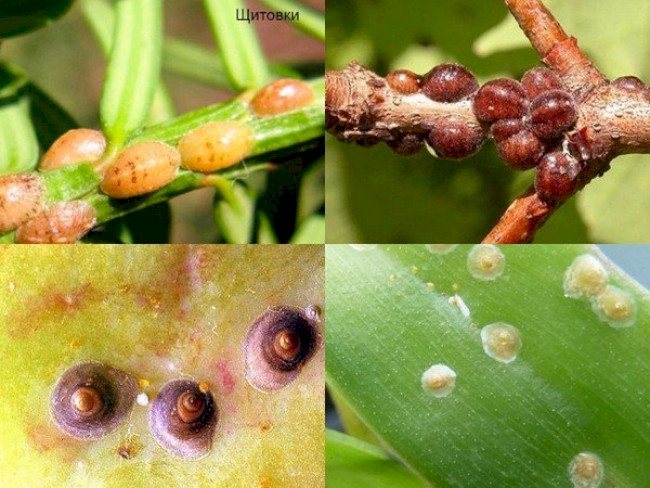

Fitoverm
Experienced gardeners are familiar with this drug. It is excellent for dealing with a variety of pests of both garden and potted plants. The drug must be diluted in a ratio of 1 ml to 200 ml of water. Fitoverm is not a highly toxic drug for humans, it does not carry the risk of serious poisoning. This is one of its important advantages, along with its high efficiency in the fight against parasites. This is all the more important, since the drug is used in a residential area where the rest of the family is located.
Prevention methods
For the purpose of prevention, we conduct a visual inspection of pets. At the slightest sign, we take the plant to quarantine in a separate room.
If there is a threat of infection (it is clear that we will not do this all the time), we prepare a solution to scare away the scabbard. To one liter of water at room temperature, add 20 g of grated garlic, 1 teaspoon of soap shavings, leave for 1 hour, filter.
We spray the plant completely. We spray the lower part of the plant, the surface of the pot with special care. This will not kill the scale insect, but it will not allow young individuals to populate the plant.
We should not allow the newly acquired indoor flowers to come into contact with the rest; we leave newcomers under supervision in a separate room for a couple of weeks.
"Fufanon"
It is the most popular preparation used for the treatment of cultivated and ornamental plants. Even in the garden, he is able to remain active for two weeks. And if we talk about greenhouses and house plants, then here the initial concentration of the drug will remain for up to a month. This is a huge plus, since you do not have to repeat the treatment after hatching. Time is enough to wipe out all generations. With the help of this drug, the fight against the scabbard on indoor plants becomes quite simple.
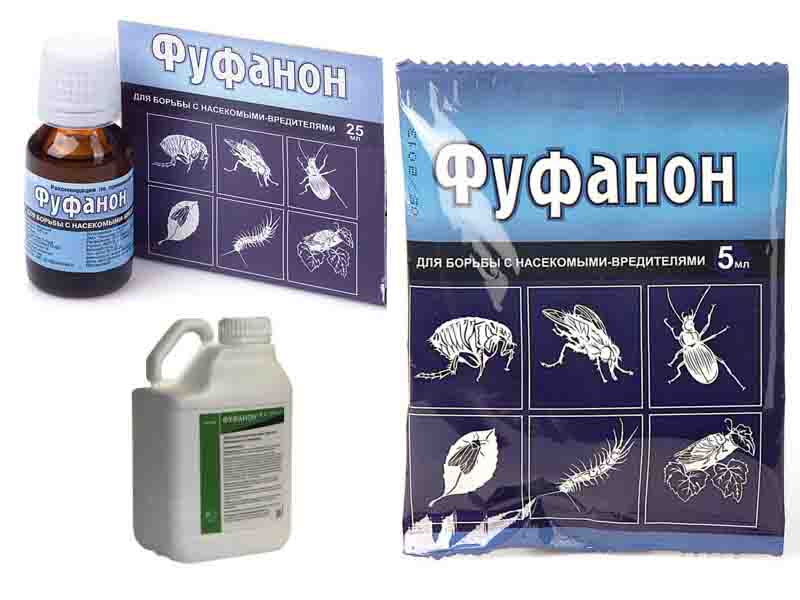

Its active substance malathion is highly toxic. This is a contact drug that acts on parasites when they directly enter their bodies, in the respiratory and digestive organs. Of course, extreme care must be taken so that pets and fish, as well as family members, are not harmed during processing.
First actions upon detection
If you noticed that the plant began to wither and wither, and then found these dark tubercles on the leaves, then it is necessary to isolate such a flower in another room, where there are no plants at all. And only after isolation can you begin to save the plant from these parasites.
Subtleties and secrets
During the treatment of the affected flower, you can resort to both traditional methods and pesticides. Having opted for the second option, it must be borne in mind that such agents can cause allergies and poisoning in young children, the elderly, allergy sufferers and pets.
On a note. Folk remedies are no less effective against the scabbard and at the same time they will not have a negative impact on people and animals living in the apartment. Therefore, most often they resort to the treatment of a houseplant using traditional medicine methods.
How to get rid of pests
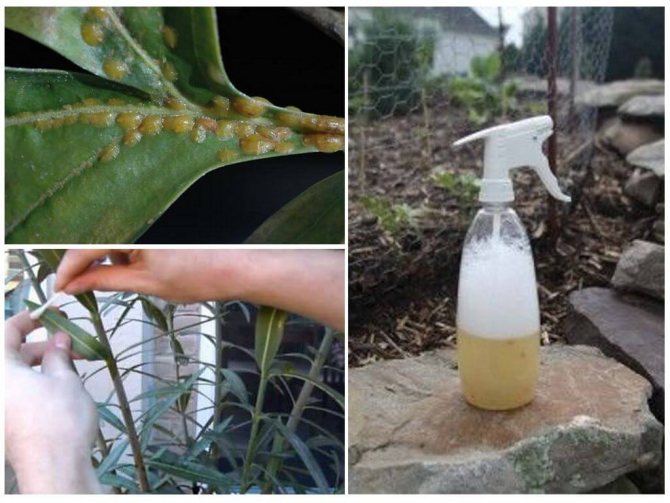

Mechanical way of fighting
There are different methods of dealing with the scabbard. Before using any of them, you must follow clear rules:
- First, you should find a center of pest spread on the plant. Usually this is a flower on which there is a large accumulation of scale insects.
- The found source of distribution must be taken to a room without plants.
- Thoroughly treat the place where the infected flower was with soap solution and insecticides.
- Scabbards are removed from a diseased plant by hand using a cotton swab previously soaked in a chemical designed to kill harmful insects (insecticide). It is not recommended to use alcohol or kerosene for these purposes, as they can leave burns on the leaves.
- Scabbards that can move can hide, so the leaves of the plant should be washed using soapy water or tobacco infusion. The treatment is carried out carefully, a toothbrush will help in this, which is dipped in the prepared scabbard remedies. The plant is left for a day, after which the solution is washed off.
- To get rid of midges in indoor flowers, the procedure must be repeated. To do this, the leaves, flower stems and soil are treated with chemicals. After two days, the insects should die. If this does not happen, it is necessary to repeat the procedure until they disappear completely, and then wash off the insecticides.
You can use a knife and a spray bottle with soapy water and insecticide to remove the scabbards.
Feedback
Since I am very sensitive to my green friends, I check them very carefully when watering. Once I discovered strange insects on my new orchid. I found out that these are scale insects, took advantage of the advice on how to deal with the scale insect on orchids, which I found on the Internet. Treated the leaves and stems with soapy water. I did the procedure for a week. The pests died.
Elena, Saratov
Description and biological features of the scale insect
Starting acquaintance with the scale insect, it should be said that it is a family of Pseudococcids. Beginner growers are easy may take her for a false shield... Therefore, the task of recognizing this pest seems to be more difficult for them. You can understand who is who by the presence of a removable shell, which is necessarily present in the scale insect. If you try to remove the shell from the insect's body, and it will continue to sit on the surface of the leaf, then we can conclude that this is a scale insect.
With a false shield, this will not work, since for her the shield is part of the body. If you look at the insect under a microscope, you will notice that the false shield has the eyes on the shield. In an ordinary scale insect, they are bred directly to the larva.
The presence of a wax shield covering the body of the insect explains why it received such a name. This pest is rather small and has a length of about 5 mm. However, these insects can vary in size.During the laying of eggs, the females sit on them and close them until the offspring appear. Usually females live no more than 3-4 months... Males show increased mobility, some are able to fly. However, their life span is short and is no more than two to three days.
When larvae emerge from the eggs, they begin to move throughout the plant until they can gain a foothold on it. From that moment on, they do not change their location, remaining in this state until they form a waxy shell.
Regardless of age, each of these individuals causes significant harm to plants throughout the year. For them, their food is the sap of plants. Moreover, even plants that are poisonous to humans can take a fancy to the scale insects. You can notice signs of plant damage by a pest by how young shoots begin to dry out. Subsequently, the formation of new ones stops, yellowing of leaves and stemsthat ends with their falling off. If you miss this moment and do not take timely measures, then you can lose the plant.
In most cases, scale insects are found on horticultural crops. Although they can appear on indoor plants, this happens much less often. But in any case, the plants suffer greatly from them, which may result in their complete death. Among all the plants that most often suffer from scale insects, citrus, palm and bromellow should be highlighted.
What does a plant affected by a scabbard look like?
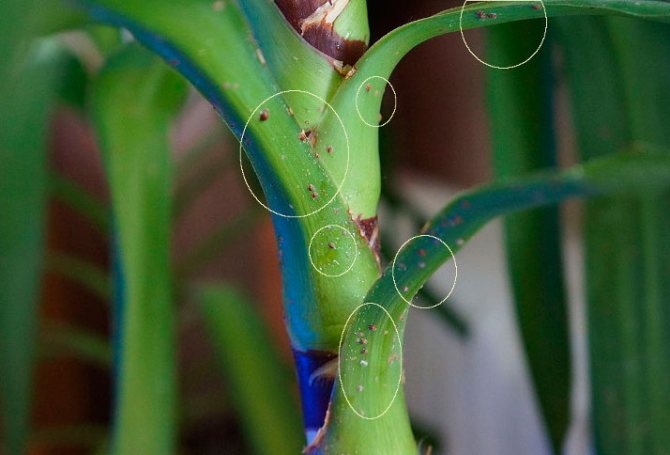

The danger of scale insects is that these parasites are able to completely suck the juices from the plant, leaving no chance for them for further development and growth. When the flower is affected by the scabbard, it begins to become covered with brown spots, which entails the complete death of the affected parts of the flower.
The characteristic lesions of indoor plants with a scabbard include:
- In places where parasites accumulate, a slight bloom is noted, which looks like brown tubercles.
- If the scale insect has settled on the plant, then you can notice a slowdown in its growth and yellowness on the leaves, which begin to fall off. This indicates that the flower does not receive the necessary nutrients, since some of them are sucked out by pests.
- In the process of vital activity, these parasites secrete a sticky substance. Even at the beginning of the lesion, a special plaque may appear on the leaves of the plant, although the parasites themselves are not yet visible on the plant.
If you do not start the fight against this parasite in a timely manner, then in a short period of time it will be able to destroy all indoor flowers, and in the open air in the garden - an impressive plantation.
Shield: description
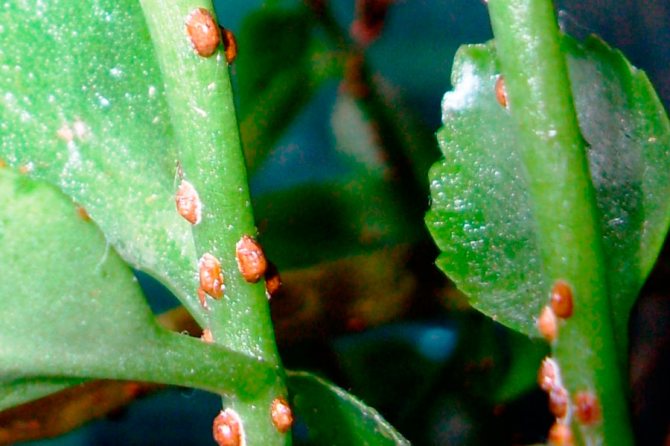

The scale insect belongs to the Pseudococcid family. The scale insect has a general resemblance to a false scale, so it is rather difficult to find out exactly what kind of insect destroys indoor flowers. The only difference is the presence of a shell that can be removed. When an insect is tried to be removed from a plant, its shell is first removed, which indicates that a real scale insect has settled in the apartment. The pest's shell is made of wax and covers almost the entire body. The scale insect leads an active lifestyle, both in summer and in winter, actively feeding on plant juices. These parasites do not bypass even poisonous plants, and if you do not start fighting them in a timely manner, then the result will be the same - all plants will die.
In addition to attacking indoor ornamental plants, scale insects prefer the garden plants they like best. This parasite can be seen on many plant species such as citrus fruits, bromeliads, palm trees, etc. To save the plant from death, you should not postpone the fight against such pests, "for later." For greater effect, it is better to use all available methods of struggle, including folk recipes, as well as preventive measures.
Folk recipes
In the initial stages, folk remedies for the scale insect effectively help. What can be used from home remedies:
- Ethanol. It is used to treat orchids with thickened leaves. A cotton pad is moistened in alcohol and the leaves are wiped. Causes burns on thin leaf blades;
- Soapy solution with alcohol. Wipe the lesions. Prepare in the following proportion: 10 ml of ethanol, 1 liter of liquid, 50 ml. liquid soap;
- Garlic cloves. With a slight infection, the teeth are crushed into gruel and applied to the tubercles where the scabbard is hiding;
- Onion infusion. The onion, crushed to a mushy state, is poured with 200 ml. water. Let it brew for 2-3 hours;
- Olive oil. Proven affordable tool. 2 tbsp is poured into 1 liter of liquid. l. oils. Stir well. Apply to the area with tubercles. The oil will disrupt gas exchange, close the access to oxygen. The procedure is carried out once every 7-10 days;
- Hot peppers. An infusion is prepared for processing. Finely chop 50 grams and boil. After draining, insist for a day;
- Soap-kerosene mixture. Rub 40 grams of soap and dissolve in 1 liter of water. 5 drops of kerosene are dripping. The solution can be sprinkled with a spray bottle or used for wiping.
Processing with folk remedies is carried out repeatedly. Multiplicity 3-4 times. Intervals from 5 to 10 days.
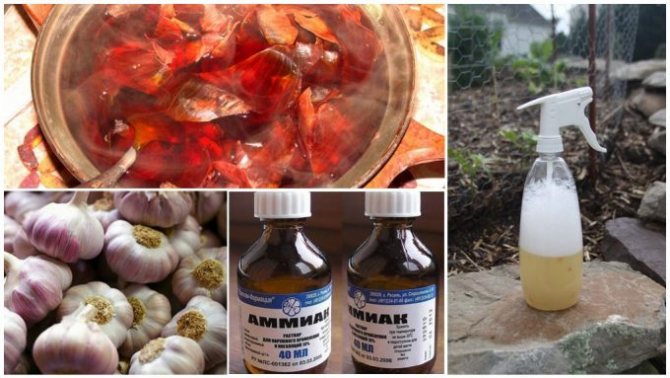

Varieties of scale insects and false scales
There are more than 2000 species of scale insects. More often than others, the following types are found:
- Pear-shaped. Occurs on stone fruit plants.
- Orange. Citrus and laurel trees are striking.
- California. Found on pome plants.
- Pine. A favorite habitat is pine.
- Mulberry. Fruit and ornamental trees and shrubs are affected.
- Palm. It affects plants of palm origin.
The false shield does no less harm. It is very easy to recognize it. The shield of the false shield is attached to the body, and in the real shield, the shield is easily separated from the body. If there is a false scale on the leaves, branches, stems, then you will learn how to deal with it from our article.
The use of professional drugs
You can get rid of the scabbard on currants in one treatment, if you choose an effective drug, react to the problem in a timely manner. It is necessary to prevent infection in the spring, before the leaves bloom.


Preparations for the pest of currants.
It is not recommended to process during flowering, as bees may suffer and yield will decrease. You can not process currants during the ripening period. The optimal option for using insecticides is early spring, late summer after harvest. In the interval, folk remedies should be used.
Note! Insecticidal preparations retain their properties from 1 to 3 months. Processing in early spring protects the currants from the scabbard for the whole summer. But the effectiveness of the product is reduced by torrential, prolonged rains in the first week of treatment. Re-spraying is allowed after a month.
The following drugs are highly effective and affordable:
- Actellic. The solution is prepared immediately before use. Spray from a garden spray bottle or spray bottle. Not addictive to insects.
- Aktara. An effective broad-spectrum drug. The active components concentrate in the leaves, poison the pests through the esophagus. Among the disadvantages is an unpleasant odor.
- Tanrek. Spray currants, water the soil, apply to the bark. Protection is enough for several months. It is imperative to carry out the treatment from the scale insect in early spring, late autumn.
In addition to insecticidal agents, bacteriological ones can be used. It is recommended to process twice a month. It is necessary to get rid of the scale insect in a timely manner. If everything is left to chance, the currants may simply die.
You always want to keep your carefully grown plants healthy.Protect them from pests and diseases. We hope our simple tips will help you overcome these harmful creatures.
Chemical treatment
Fighting the parasite manually is not easy, so many growers prefer to destroy the pest with chemicals. It is not advisable to carry out such cleaning on fruiting plants.
It is recommended to use as a chemical:
- Intravir;
- Actellik;
- Aktara;
- Mospilan.
Before spraying the plant, you need to do some manual cleaning. Then prepare the solution according to the instructions, and treat first the aerial part, and then the plant itself. Remember to take precautions. Treat with a mask and gloves, as these drugs have a certain level of toxicity.
It is recommended to remove the top layer in the pot, because it can contain eggs and larvae of the parasite. Repeat the procedure after a couple of days.
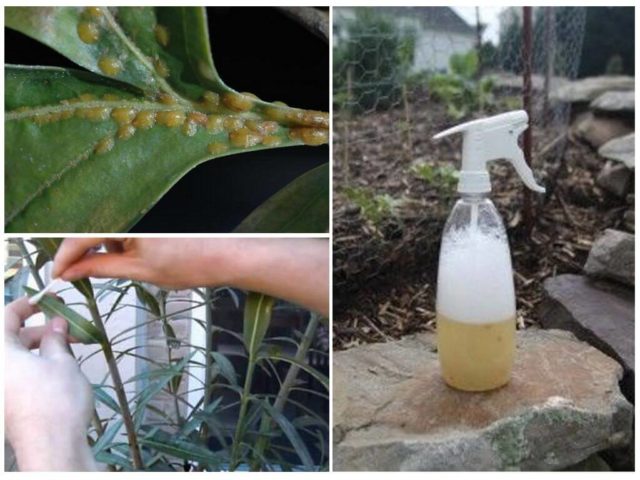

You need to do manual cleaning before spraying the plant.
Preliminary activities
First of all, it is necessary to identify the source of infection of the flower garden - the plant on which the scale insects settled.
On a note! It is rather difficult to determine exactly where they came from, since the eggs of these pests could have been brought in with the soil, and with new specimens, and even with the water that you used for irrigation.
The infected plant or plants should be isolated immediately. It is advisable to remove them in a room where there are no flowers, and only then start treatment. In this case, it is necessary to take into account the fact that the greatest activity of the scale insects is usually shown at the beginning of spring and in winter - during this period the flowers are weakened, since either they are recovering after the winter "sleep", or are at a dormant stage.
Recommendation! For this reason, during the winter and early spring, it is necessary to inspect the plants more often, do not forget to apply top dressing in time and sometimes moisten it with a spray bottle.
Prophylaxis
Newly acquired flowers are carefully examined. Suspicion is caused by:
- Warts;
- Spots;
- Bulges;
- Dark grain;
- Sticky pad.
New plants are kept in quarantine for 14-15 days, maintain good light and humidity. To do this, place a flower in a greenhouse or greenhouse. Light and plenty of moisture are unattractive for scabbard breeding. For processing the leaves, growers advise Neem oil, which is obtained from the seeds of the same tree, which resembles an olive. The active ingredient is sulin, which shows a strong repellent effect.
Description of scale insects on indoor plants
The pest is a member of the family of Hemiptera herbivorous insects. In total, there are 2600 species of scale insects. A wax shield covers the top of the skin. Hence the characteristic name. Insects, like midges, suck out cell sap. When the parasite appears on the leaves, characteristic tubercles are formed. In pests, signs of sexual dimorphism are clearly manifested. Males and females differ in external structural features.
Characteristics of females:
- Oval-rounded body;
- Length 1.5-2 mm.;
- Immobility after strengthening the flap;
- The piercing-sucking mouth organ;
- Complete absence of antennae, limbs, wings;
- Covered with a hemispherical shield, rounded or convex;
- The surface consists of larval skins and a secretory section;
- The life span is several months.
The scutellum is colored brownish-yellow or brownish-golden. The body underneath is pale sandy or white. The skins differ in color at different times.


Description of males:
- The oral apparatus is reduced;
- Move with wings;
- There are organs of vision, legs and wings;
- Coloring orange, gray;
- There is a head, chest and abdomen;
- The surface skin is fluffy, whitish or silvery;
- The scutes are small.
Male representatives live for several days. They do not harm plants, since they do not have a mouth organ. They carry out the only mission - the fertilization of females.
On plants, 70-80% are predominantly female, since males die after mating. Females die after laying with the appearance of young larvae.
Why does the scabbard appear in the house


Flowers and other plants in an apartment can become infected with pests from new flowers purchased from a flower shop. Adults of scale insects practically do not move around the plant and prefer to feed on its juice in one place all the time. But young individuals are actively moving in search of more attractive places consisting of young shoots. Having bought a new plant in the store, it is better to immediately quarantine it, placing it separately from the flowers. First, the flower must be treated with warm water and transplanted into fresh soil.
It is also advisable to treat the pot with boiling water so that the parasites have no chance of survival. Such safety measures can protect indoor plants from many parasites, not just the scabbard. Before determining a new flower for a permanent place, you need to examine it for several days in a row for the vital activity of various pests. If no activity is noticed, then the plant can be installed in the place designated for it.
Preventive measures
To prevent the appearance of scale insects, you must:
- Inspect flowers periodically for parasites.
- Every day, it is better several times a day, to ventilate the room where the flowers are located.
- Spray the plants as often as possible, after making sure that this is not contraindicated for them.
- Avoid stagnation of water in the trays of flower pots.
- Arrange flower pots, avoiding crowding.
- Withstand new plants in a 7-day quarantine.
- Buy soil only in trusted stores. If you prepare the soil yourself, sterilize it before use.
- Observe the watering regime, avoiding waterlogging of the soil.
- Provide plants with optimal lighting.
Loading ...
Brief summary
To get rid of the scabbard, they start processing immediately when the initial signs appear. Mechanical cleaning is carried out with soap and detergent solutions. They use folk remedies, effective insecticides, available remedies to treat fleas in cats and dogs. Adhere to the frequency of treatment 2-3 times, which will avoid recurrent infection.
Now read:
- How Chinese cabbage is grown outdoors
- The use of hydrogel in the open field for growing plants
- Increased yield of potatoes using Dutch technology
- Planting to decorate the site with three types of conifers
About
Agronomist of the state agricultural enterprise "Garovskoye" of the Khabarovsk region of the Khabarovsk region.
Prevention against the appearance of the scabbard
The premises must be regularly ventilated, especially in early spring, and indoor plants must be sprayed.
Regularly inspect the leaves from the upper and lower sides, it is on these parts of the plants that pests first settle.
Avoid overcrowding and spray more often.
Reproduction of scale insects slows down with prolonged exposure to sunlight. Keep windowsills and flowerpots clean.

